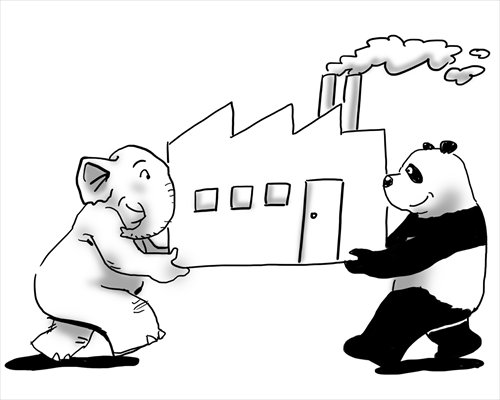HOME >> OP-ED
China-India competition can upgrade globalization
By Ding Gang Source:Global Times Published: 2016-6-1 19:41:42

Illustration: Liu Rui/GT
Indian President Pranab Mukherjee paid a four-day visit to China last week. His first destination was Guangzhou, the vanguard city of China's reform and opening-up. His stop in Guangdong Province is believed to have symbolic significance.Mukherjee arrives as relations between New Delhi and Beijing offer new incentives. India's Look East strategy and China's "Belt and Road" initiative, two parallel national policies, are beginning to seek integration.
When talking about China's "Belt and Road" initiative, some Indians are wary of the repercussions of China's railway extending from Tibet through Nepal to India, such as the influx of China-made products into the Indian market.
This concern has suspended the reconstruction of the Stilwell Road that connects China, Myanmar and India. On the west end of the road at the Myanmar-India border, small commodity markets are filled with China-made products that flood into India's poor northeastern region.
However, when railways and highways connecting China and India are completed in the projected next five years, perhaps Indians will no longer harbor such concerns.
Just ahead of Mukherjee's visit, Apple CEO Tim Cook and Foxconn Chairman Terry Gou made trips to India, announcing plans to relocate their factories from China to India. Foxconn plans to build 10 to 12 factories in India by 2020. What's more, many Chinese enterprises are showing interest in investing in India.
There are two countries that have the highest potential to replace China's position in the global value chain - Vietnam and India. Their labor costs are lower, and they have already begun taking low- and middle-end manufacturing from China.
The rise of "Make in India" will probably bring China and India into more fierce competition in some industries, but it will also create more space for mutual development.
The key to maintaining the upward trajectory of their economic ties is to reduce direct rivalry and find more industrial connections. Such joint efforts in different industries will produce unprecedented benefits and reinforce the value chain of shared interests.
Many Indians fear China's growing presence. Such a sentiment arises from years of estrangement despite being neighbors.
Conservatism emerges in fear of competition. When competitiveness of "Make in India" is lower than "Made in China," the railways will ignite concerns among Indians about China-made products.
Such concern is one of the major barriers that obstructs India from introducing more foreign investments into local manufacturing and hinders the revenue streamlining process.
Surpassing China is no longer a long shot for the Indians. When the growth of the Indian economy speeds up, and manufacturing becomes more competitive, the Indians will be more open-minded toward China.
As the Chinese steel, construction, machinery, textile and electronics industries are eager to enter the Indian market, and India's IT, pharmacy and chemical industries are waiting to tap into the Chinese market, there is a great need for a platform where industries, capital and technologies can connect.
Industrial cooperation can help reduce distrust between Indians and Chinese.
The future direction of the Sino-Indian relationship depends on whether the nations' economic activities can alleviate their long-standing concerns.
Industrial cooperation can directly benefit the growth of both countries, weaken nationalist sentiments embedded in both societies, and offer new perspectives on each other's rise.
China and India should be encouraged to look at the big picture rather than a disputed patch of land. China and India's industrial cooperation will usher in a new climax of globalization.
The author is a senior editor with People's Daily, and currently a senior fellow with the Chongyang Institute for Financial Studies at Renmin University of China. dinggang@globaltimes.com.cn. Follow him on Twitter @dinggangchina